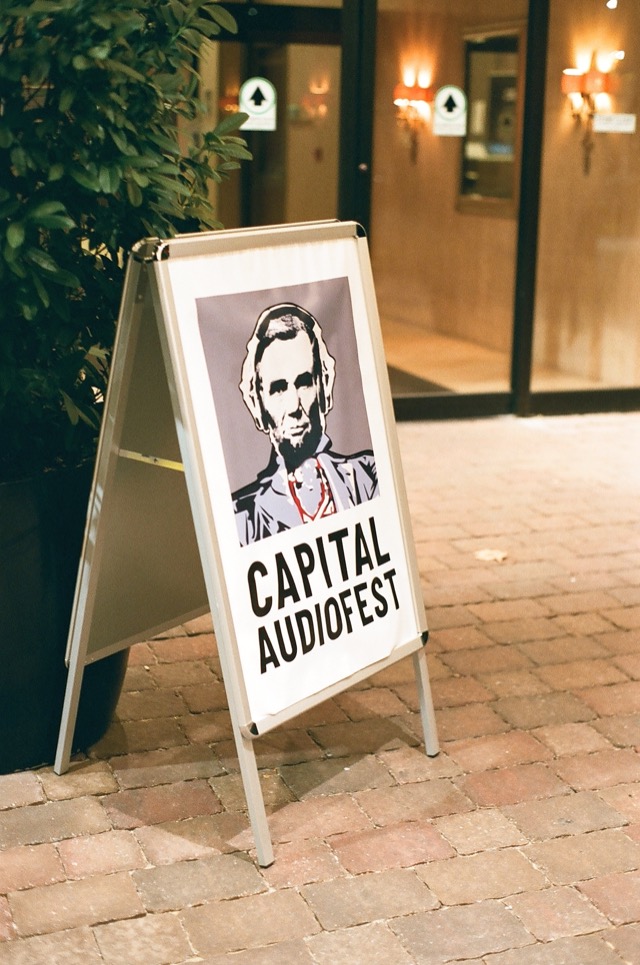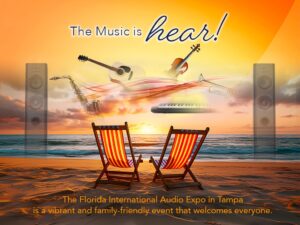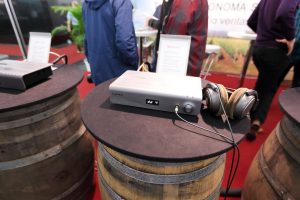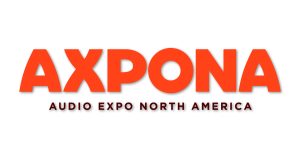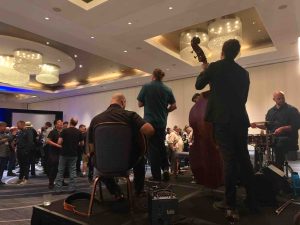
The Capital Audiofest is one of the few true high-end audio shows left in the world, and as the industry shrinks all of these shows become more and more important. Long-time readers will recall that I have very mixed feelings about the current state of the high end audio industry, and because of that I think the shows are that much more important. There is a lot of amazing work going on, and there's a lot of junk, and the only way you'll know the difference is by actually experiencing it for yourself. The Capital Audiofest is one of the few places where you can go to actually experience what is going on in the industry.
I only got a day or so at the show, so I can't claim to have seen everything there was to see or listened to everything there was to listen to. And there was a lot of stuff I saw and listened to that I don't have the time and opportunity to mention here, so if I missed your favorite thing at the show, or you don't think I gave a fare shake to your favorite thing, I apologize but I'm only one person trying to see as much as I can in a limited time.
A lot of the booths were run by dealers, but I'm writing here about equipment rather than dealers, so I may neglect to mention the dealer exhibiting something too.
So first, let me talk about loudspeakers. Now, one thing that I noticed is that a number of the speakers that sounded good at the show had Positive Feedback awards already when I went back to look them up. I think that's a good sign.
Deja Vu Audio was showing off a lot of products but one of the most impressive ones was the Harbeth 30, which is a refinement of the mid-sized BBC LS 5/9 monitor, updated for the new millenium. I always liked these speakers, they are clean and understated and very British and the new generation very much has the same character that I liked in the older generation of Harbeth speakers.

Another classic British design on display was the Audio Note J, although sadly the room problems in their demonstration were very severe. This is a small and clean 2-way system with a classic British sound but the poor hotel room quality made it hard to tell much.
A totally new design was The Clue from Sjofn HiFi. This is a little bookshelf sized box, selling at $1000/pair, but very clean sounding for a $1000 speaker.
The top end was clear and maybe a little etched but not spitty at all. It was impossible to judge real imaging because of the unavoidable room problems at the show, but these definitely are interesting and deserve to be listened to under better conditions.
Another newcomer was the Vanatoo Transparent One speaker. This is a trick design that relies on extensive dsp, and normally I am not a fan of such designs, but this really sounded good in the room. Again a small bookshelf sized box, this uses a long-throw subwoofer with some processing to get clean and remarkably flat response down to 48 Hz, below which it drops like a rock. Playing back several recordings of mine I can attest to the truth of this... the low end was clean and solid and although it wasn't extended and you couldn't hear the fundamental on the doumbek that was around 40 Hz, it was still very remarkable for such a tiny box. What was even more interesting was that the room problems inherent in these hotel rooms seemed to be excited a lot less by the fact that the dropoff on these speakers was so dramatic. They were a little bit too forward and a little bit too close sounding for me, but a larger room would probably have fixed that nicely.
These guys are active speakers with the amplifiers and the dsp built into the box, so there's little tweaking to do. This is an odd kind of product; it isn't the kind of thing that high end audio people would go for, but it sounds much too good to be sell as a standard consumer product.
I really hope the manufacturers find a place for this because it fills a demand out there.

Zu Audio was showing their Definition Mk IV speakers, a 2-way system with the crossover point so high that you can probably think of them as full-range drivers with a little supertweeter added. Very clean sounding, with good top end without being spitty, and this was one of the few systems I heard at the show that was able to provide a stable and coherent image in the acoustically-terrible cubical cement rooms being used for demos.

Zu also was making T-shirts with a huge rubber stamp arrangement, which worked out remarkably well. Definitely the best shirt of the show.
Ginkgo Audio was showing their Claravu speaker, which was another one of those few. The demo had big room problems on the low end but the speakers had a convincing image, a very wide sweet spot, and a clean top end and would definitely be worth hearing in a better (and larger) room. And, BG Radia was demonstrating their FS-880 full range active speaker system, using a line-array of small planar ribbon drivers combined with conventional woofer drivers on the bottom.
Kent McCollum from Electrostatic Solutions was there showing off some restored Quad ESLs. He rebuilds them from the bottom up, but keeps the existing panel designs. No modifications, no changes, just a clean rebuild that brings the Quads back up to the original specifications. He might be the only person still doing this work today, so if you have Quads in need of some work he is the guy to call.

Down the hall, the folks from Music Technology in Springfield VA were showing their workmanship rebuilding Apogee speakers. These guys actually do a wide variety of repair and restoration work but I think the most impressive thing in their booth were the Apogees. There are a lot of them out there, there are many of them that don't meet original specifications, and these guys can remedy that.
It seemed like there was a lot less electrostatic stuff this year, and although Enigma Acoustics was showing their Self-Biased Electrostatic Loudspeaker, I was unable to get in to actually listen to it. This is a shame since this is the kind of new design that I go to the shows to see, so I'm really going to hope they're back next time so I can give them a proper listening.
Something I found very interesting was that Salk Signature Sound, a manufacturer of some very fine-looking loudspeakers, had gone in with another loudspeaker company, Philharmonic, on a room. I have heard and liked some of the Philharmonic speakers and apparently they did some work for Salk and Salk did some work for them, and what happened in the end was that two companies, seemingly competitors, came together to exhibit their products in the show. This is the kind of working together that makes the high end audio world such a great thing. How did the speakers sound? I don't know because the room was so crowded with people that I never did get a chance to give them a proper audition. I feel bad about that, but enough other people were crowding into the room that there must have been something worth hearing there.

Madison Fielding was showing the Flagstone, an outdoor planter with a speaker built ino it. And you know, remarkably it didn't sound bad. Maybe a little bass heavy since it's in a room, but if you put it out on the porch it would probably sound pretty good. Audax tweeter and midrange, Electro-Voice professional grade woofer. It's not exactly high-end, and not up to the level of the best indoor speaker systems, but for God's sake it's a plant stand and it sounded better than a plant stand has any right to sound.



Classic Audio Loudspeakers was showing off some very nicely-made replicas of classic horn designs, and Live Sound Designs was showing off their Grand Theatre System, a newly designed 2-way with a wooden sectoral horn and a bass horn.

I normally don't like to talk about the things at the show that don't sound good, but I was kind of shocked at the Staccato speaker shown by Sadurni Acoustics. Three big red horns with acoustic centers several feet apart, so you could hear wild comb filtering in the crossover regions as you moved your head around.

Now, one of the problems with listening to loudspeakers at the show, as you might expect, is the terrible quality of the listening rooms. Vendors don't really have any control over the rooms that the hotel provides, but they do have the ability to do some room tuning to make the best of a bad situation. Command Performance AV was showing off a wide variety of acoustic absorbing devices from Vicoustic and they definitely made a big difference in their demo room, dealing well with some of the slap echo issues from the windows which plague all of these rooms.
Another acoustical company, GK Acoustics, was showing off some products in a couple of demo rooms. These guys have a wide variety of different acoustical devices for different applications, from absorbers and diffusers to tuned absorbers to deal with specific room resonances. I talked with their guys and they seemed very interested in actually helping people fix room problems rather than just selling product as quickly as possible. They offer a free consulting service to help people understand acoustical issues in their rooms and while you might expect them to be a little biased toward their own products, certainly getting a little acoustical advice on your room is the first step toward better sound. I think this is the most neglected part of the whole playback system and that a few dollars spent on the room will do more than a lot more money spent elsewhere in the chain.
Other things you can hang on the walls next to your acoustical absorbers is the Tana turntable shelf from Kanso Audio Furniture. This is a very ingenious isolation platform for the turntable that hangs off your wall. Kanso had a wide variety of audio stands and furniture for sale and a fine demo set up in the lobby, but the turntable shelf was just so eye-catching I hardly had time to see the rest of it because I spent to much time tapping on it and marveling.

Lots of power amplifiers were at the show and one of the more innovative marketing tactics I have seen were a large number of expensive power amps that were really just cheap Class-D modules boxed up nicely.

Ignoring those, we come to a lot of excellent products that really do deserve to be called high end audio amplifiers. Atma-Sphere was showing off their whole line of amazing OTL amplifiers. I've loved these things, because they have the best attributes of solid state and tube designs. I got a chance to listen to their MA-1.5 amplifier using 7241 regulator tubes to directly drive loudspeakers and they had a number of other designs on display too.
Border Patrol also had a line of various nicely-made single-ended and push-pull tube amplifiers on display, but what I found more interesting is that they are now making a DAC with a USB input, based on the very clean TDA1543 D/A sigma-delta converter chip which is very popular in a lot of higher grade products. They're building them into a very well-crafted wooden cabinets too, a good mechanical design for something that mostly sits in the back of the rack and doesn't need to draw attention.

Lots of other DAC products out there including of course the classic Benchmark DAC-1, but what I found new and innovative was that for the first time there have been a number of "music server" devices, dedicated computer systems intended only as sources for music streaming. Core Audio Technology was showing their Kryptos Music Server, a Windows Server 2012 based box intended as a streaming server for high resolution audio files.

There were a bunch of preamps out there, including the Modwright LS 100, a well-designed and solid conventional tube preamp, and the Backert Labs Rhythm 1.1 which was a new design that was anything but conventional.

There are a couple interesting new innovations going on with this preamp. First of all there is a servo control loop for setting quiescent bias on the preamp tubes, which is claimed to reduce differences between tubes when compared with simple cathode bias. Secondly, there is a rather ingenious trick power supply (which you can find in US Patent 8,411,475) which uses additional phase shift capacitors in order to shift the zero crossing points of each rectified pulse so that there is no time in which the supply rectifiers aren't producing power. This allows the big supply reservoir caps to be replaced with much smaller film capacitors combined with a little regulation. This is all rather cool and ingenious. Does it translate into better sound? I can't tell under show conditions so I urge you to try the Rhythm preamp and see for yourself.
There was a good bit of phono stuff although I think this year there were fewer mid-priced turntables than in previous years. A number of rooms were using the TW-Acustic turntables, which are very much solid no-holds-barred designs.

But what really surprised me was the room from Soundsmith. These folks are making a wide variety of excellently crafted phono cartridges in their shops in New York. In addition to conventional designs, they were showing off a strain gauge cartridge, something that hasn't been seen on these shores for many years. The SG-200 was very clean and recessed sounding and it is very good to see this design back again.

Ultrasonicrecords.com was showing off their ultrasonic dunk-tank record cleaner. This is an ingenious design that rotates records through the tank so that a fairly small tank can be used for eight 12" records at the same time while keeping the label out of the tank and free from any possibility of damage. Maybe you have a vacuum machine, and the vacuum machine is great for final cleaning of records but the ultrasonic tank will take filthy records that would gunk up your vacuum machine.

On the subject of LP records, Cuneiform Records was there. These guys run a record label that is not expressly oriented toward audiophile records, but they care about sound quality in a way that few record companies still do.

And yes, they're still issuing excellent LPs. And yes, they have the famous Microscopic Septet in their catalogue.
I only saw one other record company there, AIX Records, which goes out of their way to bring some of the highest quality audio recordings made today out on Blu-Ray. I definitely missed seeing more record companies at the show but the two that were there had some fine catalogues.


United Home Audio was showing off their tape machines, playing back a mixture of master tapes and low-generation dubs off of master tapes. Good sound, and the mbl speakers they were using had some of the cleanest sound in the show.

But, what was really interesting this year was CanMania, a headphone event taking place on the fourth floor. I have viewed with a bit of confusion so far the burgeoning interest in high quality headphone sound, and the creation of a bit of a subculture of headphone listeners. My friend BC keeps talking to me about all of these obscure headphone companies and all these portable amplifier things, and I kind of have looked at him as if he was some kind of alien. So going to CanMania, I got to understand what he was talking about, and if I am not going to sell my speakers any time soon I am still very pleased to see this bringing more people into the high end community.


Oppo was showing their HA-1 headphone amplifier along with their PM-1 planar magnetic headphones, a very natural sounding combination. Oppo is just getting into the transducer business for the first time and so this is a very big step for them.

Hifiman was also showing off a planar magnetic design, the HE-560, which again was very smooth and clean. They also had some portable headphone amplifiers and DACs that looked to be of fine quality.
Woo Audio was showing some large tube headphone amplifiers, and my basic thought about that sort of thing was that it defeated the portability that was what people needed with headphones. However, one of the other attendees talked about how he was in a small apartment and didn't have the ability to set up a proper speaker system, and so headphones were how he listened in a fixed location, and several other people there agreed with him about being in similar situations. So perhaps this is part of where this growing headphone marking is coming from. Devices like the Woo amps give people an opportunity to experience high quality audio in places where they would never have been able to hear it before. And, if the imaging on headphones is never realistic when playing back conventional stereo recordings, still tonality is more important than imaging.

And, one of the issues about tonality is that because everyone's ears are physically shaped differently, earphones that give measurably accurate response on one person's head may give very different response on another person's head. That's not a matter of taste, that's a matter of actual physical response differences, and this is why it's so critical to listen to headphones before buying them.

The folks at cleartunemonitors.com make in-ear earphones, with custom earmolds. They aren't the only people that make such things, but they are the first people I have seen that made their entire line available at an audio show with generic eartips so that people could audition the whole line properly. Almost everybody buying in-ear monitors are forced to buy without proper listening, but these folks made it possible to actually hear what the things sound like in your ears. I found their CT-400 to sound the best of their line to me... but you might find some other model to sound better depending on your ear geometry, and you won't ever know it without listening. This auditioning arrangement was one of the best things in the show.
Astell and Kern was showing off their "portable high fidelity sound system," an iPod device designed for high fidelity audio files and with higher grade DAC and amplifier circuits than you'll find in the typical consumer players.
Built very solidly, this again points to a real demand for high grade portable systems.
It was a good show, I heard a lot of stuff that seemed interesting and talked to some interesting people. I was disappointed in the lack of DIY stuff, and the local DIY club did not have a room this year as they had in previous years.
Nor was a lot of odd DIY gear represented as had been the case before. Still, I think that was made up for somewhat by the headphone exhibit which brought in a lot of people in the growing headphone community and maybe exposed them to seeing the rest of the show as well.
With the wide disparity of gear in the high end audio world, shows like this are absolutely essential in getting people to sit down and actually compare equipment. I wish more vendors had spent more time trying to control acoustical problems in the rooms, and I would like to have seen more acoustical control products on display there at the show, but then again I could say the same thing about pretty much every other high end audio event (and far too many home audio systems).
It's one thing, though, to read about the show and the equipment that I liked and disliked, and a very different one to go out to the show with a record you like and listen to the music that you enjoy on a variety of systems. The next Capital Audiofest is going to be July of 2015 so start making plans for it now.








